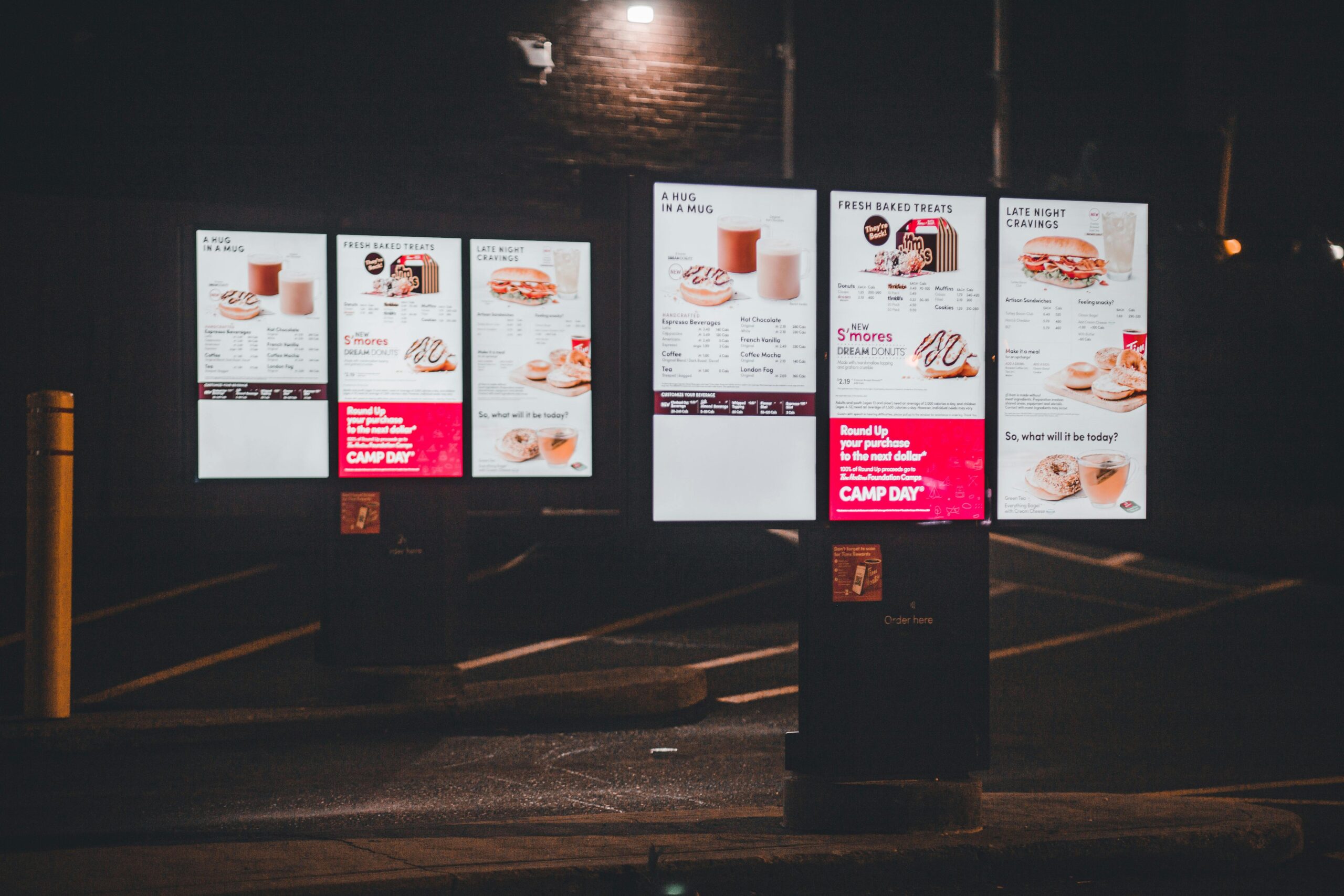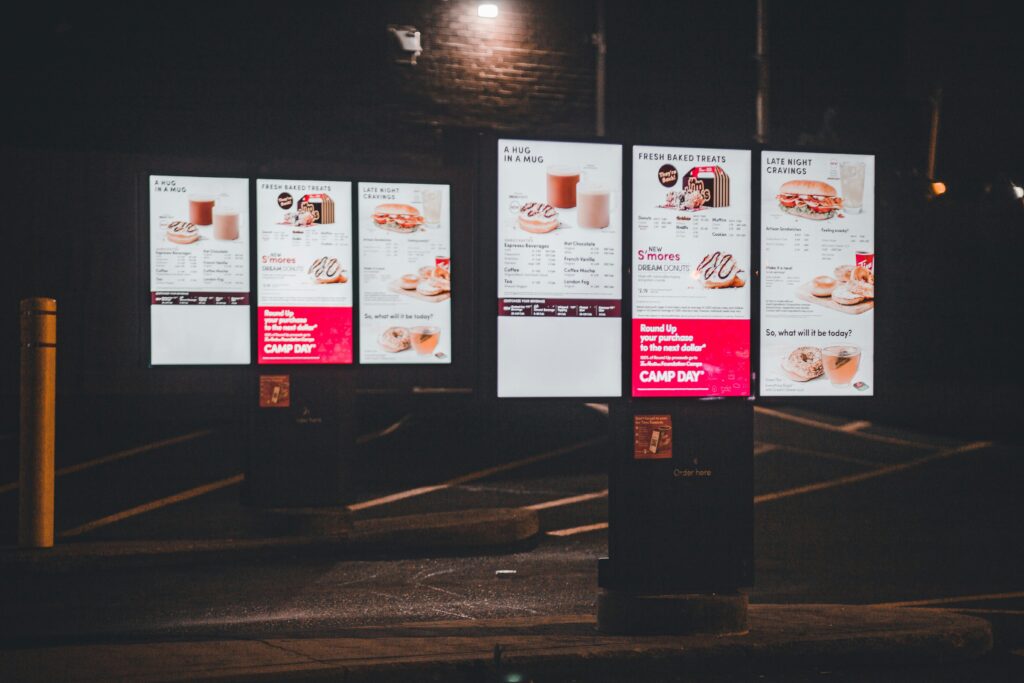
The Impact of Digital Menu Boards on Modern Restaurants
Table of Contents
ToggleSharing is caring!
Reading Time: 4 minutesDigital Signage and Digital Menu Boards
In today’s fast-paced, technology-driven world, the restaurant industry is undergoing a transformation like never before. Digital menu boards are at the forefront of this change, revolutionizing how restaurants engage with their customers and manage their operations. These high-tech displays are more than just eye-catching screens—they are powerful tools that enhance customer experience, improve efficiency, and drive profitability. This article dives deep into the world of digital menu boards, offering insights for business owners, marketing professionals, and technology enthusiasts.

A Brief Journey Through Time: The Evolution of Digital Menu Boards
The Humble Beginnings
The journey of digital signage began in the late 20th century when businesses started using basic television screens to display advertisements and information. These early signs were rudimentary and static, merely serving as electronic versions of traditional posters and menus.
The Technological Boom
As technology advanced, so did digital signage. The early 2000s marked a significant leap with the introduction of high-definition screens and more sophisticated software. Restaurants began to see the potential of these tools, gradually adopting them to replace their static menu boards.
The Modern Era
Fast forward to today, digital menu boards have become a staple in many eateries. From fast-food chains to gourmet restaurants, these boards utilize cutting-edge technology to offer dynamic, interactive, and visually appealing menu displays. They are now an integral part of the dining experience, influencing everything from customer satisfaction to operational efficiency.
Understanding Digital Menu Boards
Digital menu boards are electronic displays that present menu items, promotions, and other relevant information in restaurants. Unlike traditional printed menus, these boards are dynamic, allowing for real-time updates and interactive features. They often include high-resolution images, videos, and animations, making the dining experience more engaging and enjoyable for customers.
Digital menu boards offer a variety of benefits
Boosting Customer Engagement
One of the most compelling benefits of digital menu boards is their ability to capture and retain customer attention. High-quality visuals of food items can stimulate appetites and encourage impulse purchases. Moreover, digital boards can display detailed information about ingredients, nutritional content, and special offers, fostering transparency and trust with customers.
Flexibility and Dynamic Content
Digital menu boards offer unparalleled flexibility. Restaurants can quickly update their menus to reflect daily specials, seasonal items, or limited-time offers. This adaptability is particularly valuable for businesses that frequently change their offerings or want to experiment with different promotions without incurring the costs of printing new menus.
Cost-Effectiveness and Enhanced ROI
Although the initial investment in digital menu boards can be higher than traditional signage, the long-term benefits often justify the expense. By eliminating the need for printed materials and enabling instant updates, digital boards can significantly reduce operational costs. Additionally, the ability to promote high-margin items and cross-sell through dynamic content can enhance sales and improve ROI.
Key Technologies Driving Digital Signage
Diverse Display Options
Digital menu boards come in various forms, each suited to different restaurant environments and business needs:
- LCD and LED Screens: The most common types of displays, known for their bright, clear visuals.
- Projection Systems: Ideal for large, open spaces where traditional screens may not be practical.
- Interactive Touchscreens: Allow customers to browse the menu, customize orders, and even make payments directly from the screen.
Sophisticated Content Management Software
Effective content management is crucial for maximizing the benefits of digital menu boards. Various software solutions are available to help restaurants manage their digital signage, offering features such as:
- Cloud-Based Management: Allows for remote updates and real-time content changes across multiple locations.
- Scheduling Tools: Enable restaurants to display specific content at designated times, such as breakfast menus in the morning and dinner options in the evening.
- Analytics and Reporting: Provide insights into customer behavior and menu performance, helping businesses make data-driven decisions.
Real-World Applications and Industry Use Cases
Transforming the Food Industry
Digital menu boards are revolutionizing the food industry, enhancing customer experiences across various types of eateries:
- Fast Food Chains: Giants like McDonald’s, Burger King, and KFC use digital boards to streamline order-taking, promote combo meals, and display calorie counts.
- Cafes and Coffee Shops: Starbucks and Dunkin’ Donuts utilize digital menus to highlight seasonal beverages and pastries.
- Fine Dining Restaurants: Upscale establishments use digital boards to showcase their wine lists, chef’s specials, and tasting menus, elevating the dining experience.
Beyond Restaurants: Expanding Horizons
While the food industry is a primary adopter, digital menu boards are also making their mark in other sectors:
- Hotels: Digital boards in hotel lobbies can display restaurant menus, event schedules, and local attractions.
- Airports: Food courts in airports use digital menus to cater to diverse, international travelers with varying dietary needs.
- Retail Stores: Some retail environments use digital signage to promote in-store cafes and food sections.
The Future of Digital Menu Boards: Trends to Watch
Seamless Integration with Mobile and Online Ordering
As restaurants increasingly adopt mobile and online ordering systems, digital menu boards are expected to integrate seamlessly with these platforms. This integration will enable real-time updates of order statuses, personalized promotions, and enhanced customer experiences.
AI and Personalized Experiences
AI-driven digital menu boards will provide personalized recommendations based on customer preferences and purchase history. For instance, a returning customer might see tailored suggestions based on their previous orders, enhancing the likelihood of repeat business.
Sustainability and Energy Efficiency
With a growing emphasis on sustainability, future digital menu boards will likely focus on energy-efficient technologies and eco-friendly materials. This shift not only reduces operational costs but also aligns with the increasing consumer demand for environmentally responsible business practices.
Augmented Reality and Immersive Experiences
Augmented reality (AR) and virtual reality (VR) technologies have the potential to revolutionize digital menu boards. Imagine customers being able to see 3D renderings of menu items or interactive displays that provide a virtual tour of the kitchen or ingredient sourcing process. These immersive experiences can create a deeper connection between the customer and the restaurant brand.
Embrace digital menu boards for the future
Digital menu boards are more than just a technological trend—they are a powerful tool that can transform the restaurant industry. By enhancing customer engagement, offering dynamic content capabilities, and providing a solid return on investment, these modern tools are indispensable for any restaurant looking to stay competitive in today’s fast-paced market.
What do you need to do?
Are you ready to elevate your restaurant experience? Embrace the power of digital menu boards and see the difference they can make in customer engagement and operational efficiency. Contact us today to learn more about how digital signage solutions can benefit your business and help you stay ahead in the competitive landscape.
This is a collaborative post
Most Popular Posts:
Sharing is caring!
PLEASE COMMENT BELOW